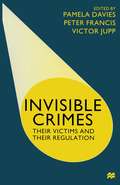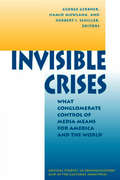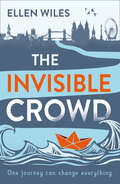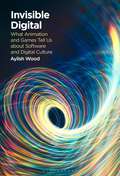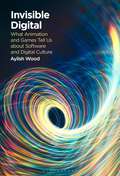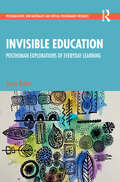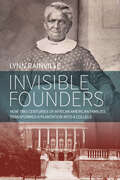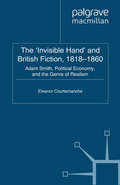- Table View
- List View
Invisible Crimes: Their Victims and their Regulation
by Pamela Davies Peter Francis Victor JuppInvisible Crimes is an edited volume containing a collection of articles from a distinguished panel of academics. The book explores many features of 'invisible' crimes and in doing so provides numerous examples of hidden crimes and victimisations. The book will be invaluable to students of criminology at both undergraduate and postgraduate level. It will also inspire academics from a range of disciplines to update, rewrite and offer new courses on neglected crimes and victimisations.
Invisible Crimes and Social Harms (Critical Criminological Perspectives)
by Pamela Davies Peter Francis Tanya WyattThis unique collection explores the continuing invisibility of much crime and victimization, and the lack of adequate responses to them. Shaping the lens through which criminology and victimology is approached in the twenty-first century, the volume examines major issues including (in)justice, risks, rights, regulation and enforcement.
Invisible Crises: What Conglomerate Control of Media Means for America and the World (PDF)
by George GerbnerAccording to the contributors to this volume, the communications media deliberately blank out critical conditions and developments whose imagery would pose unacceptable challenges to the dominant structures of culture-power. Such "invisible crises" include the suppression of information about the dehumanization and stigmatization of groups of people; the drift toward ecological suicide; the neglect of vital institutions such as public education and the arts; the way in which television corrupts the electoral process; and the promotion of practices which drug, poison and kill. The book asks why the media are, in the view of contributors, withholding vital information from the public, and focuses on the increasing concentration of culture-power that, it is argued, keeps these truths from public view.
Invisible Crises: What Conglomerate Control Of Media Means For America And The World (Critical Studies In Communication And In The Cultural Industries)
by George GerbnerAccording to the contributors to this volume, the communications media deliberately blank out critical conditions and developments whose imagery would pose unacceptable challenges to the dominant structures of culture-power. Such "invisible crises" include the suppression of information about the dehumanization and stigmatization of groups of people; the drift toward ecological suicide; the neglect of vital institutions such as public education and the arts; the way in which television corrupts the electoral process; and the promotion of practices which drug, poison and kill. The book asks why the media are, in the view of contributors, withholding vital information from the public, and focuses on the increasing concentration of culture-power that, it is argued, keeps these truths from public view.
The Invisible Crowd
by Ellen Wiles‘A fierce, big-hearted novel.’ Joe Treasure, author of The Book of Air‘Pushes us to find our kinder selves.’ Rowan Hisayo Buchanan, author of Harmless Like You‘A wonderful book.’ Maurice Wren, Chief Executive of the Refugee Council
The Invisible Cure: Africa, the West and the Fight Against AIDS
by Helen EpsteinIn 1993, Helen Epstein, a scientist working with a biotechnology company searching for an AIDS vaccine, moved to Uganda, where she witnessed first-hand the suffering caused by the HIV virus. The Invisible Cure, dramatic, illuminating and beautifully written, recounts the struggle of international health experts, governments and ordinary Africans to understand the devastating spread of HIV in Africa, and traces how their responses to the crisis have changed in light of new medical developments and political realities. The AIDS epidemic in Africa is uniquely severe. It is partly a consequence of the political, social, and economic upheavals of the past century, which have left millions of Africans adrift in an increasingly globalized world. Their poverty and social dislocation have generated an earthquake in gender relations that has had devastating consequences for the spread of the HIV virus. Epstein argues that there are ways to address this crisis that may be simpler than many people imagine. A deeply affecting story of scientific breakthroughs and false starts, and of the human costs of policymakers’ missteps and inaction, The Invisible Cure will change the way we think about AIDS, a disease without precedent.
Invisible Digital: What Animation and Games Tell Us about Software and Digital Culture
by Aylish WoodInvisible Digital helps us makes sense of something we cannot see by presenting an innovative approach to digital images and digital culture. At its heart is a novel method for exploring software used in the creation of moving images as markers of converging cultural, organizational and technological influences. The three main case studies of Invisible Digital are the animated feature Moana (2016) and the computer games No Man's Sky (2016) and Everything (2017). All three were created using procedural techniques: simulation software for Moana, and procedural content generation for No Man's Sky and Everything. Production culture disclosures associated with procedural techniques often emphasize the influences of automated systems and their algorithms, making them ideal for a study that interrogates digital processes. The approach of Invisible Digital is informed by relational theories and the concept of entanglement based on materialist perspectives, combined with insights from work that more explicitly interrogates algorithms and algorithmic culture. Aylish Wood employs the notion of assemblages to introduce the concept of material-cultural narratives. Using this conceptual framework, she draws out material-cultural narratives for each case study to demonstrate what they reveal about software and digital culture. These analyses of software provide a widely applicable method through which moving image studies can contribute more fully to the wider and growing debates about algorithmic culture.
Invisible Digital: What Animation and Games Tell Us about Software and Digital Culture
by Aylish WoodInvisible Digital helps us makes sense of something we cannot see by presenting an innovative approach to digital images and digital culture. At its heart is a novel method for exploring software used in the creation of moving images as markers of converging cultural, organizational and technological influences. The three main case studies of Invisible Digital are the animated feature Moana (2016) and the computer games No Man's Sky (2016) and Everything (2017). All three were created using procedural techniques: simulation software for Moana, and procedural content generation for No Man's Sky and Everything. Production culture disclosures associated with procedural techniques often emphasize the influences of automated systems and their algorithms, making them ideal for a study that interrogates digital processes. The approach of Invisible Digital is informed by relational theories and the concept of entanglement based on materialist perspectives, combined with insights from work that more explicitly interrogates algorithms and algorithmic culture. Aylish Wood employs the notion of assemblages to introduce the concept of material-cultural narratives. Using this conceptual framework, she draws out material-cultural narratives for each case study to demonstrate what they reveal about software and digital culture. These analyses of software provide a widely applicable method through which moving image studies can contribute more fully to the wider and growing debates about algorithmic culture.
Invisible Education: Posthuman Explorations of Everyday Learning (Postqualitative, New Materialist and Critical Posthumanist Research)
by Jocey QuinnThis original and challenging book introduces the ground-breaking concept of ‘invisible education’, theorising it with critical posthuman concepts and demonstrating it through a wide range of empirical research. Invisible education is the learning that happens in everyday life: it is invisible because it is purposively ignored and devalued, and it is education because it is powerful and formative. Far from being marginal, this is where the future is being formed. The book challenges the feel-good fiction of social mobility through formal education, replacing it with the new concept of future mutabilities, shaped through invisible education. The book is the first to bring together lifelong learning and critical posthumanism and does so in ways that are mutually illuminating. The book draws on a wide range of funded empirical research on invisible education: exploring landscapes, animals and things (material, immaterial and uncanny), activism, volunteering and work, home lives and care, and global contexts of conflict. It charts how invisible education plays a crucial role in the lives of marginalised people, including young people, activists, postverbal people, carers, women escaping domestic abuse and many others. Combining posthuman ideas with memoir, poetry, art and fiction, it is creative, intellectually stimulating and readable.
Invisible Education: Posthuman Explorations of Everyday Learning (Postqualitative, New Materialist and Critical Posthumanist Research)
by Jocey QuinnThis original and challenging book introduces the ground-breaking concept of ‘invisible education’, theorising it with critical posthuman concepts and demonstrating it through a wide range of empirical research. Invisible education is the learning that happens in everyday life: it is invisible because it is purposively ignored and devalued, and it is education because it is powerful and formative. Far from being marginal, this is where the future is being formed. The book challenges the feel-good fiction of social mobility through formal education, replacing it with the new concept of future mutabilities, shaped through invisible education. The book is the first to bring together lifelong learning and critical posthumanism and does so in ways that are mutually illuminating. The book draws on a wide range of funded empirical research on invisible education: exploring landscapes, animals and things (material, immaterial and uncanny), activism, volunteering and work, home lives and care, and global contexts of conflict. It charts how invisible education plays a crucial role in the lives of marginalised people, including young people, activists, postverbal people, carers, women escaping domestic abuse and many others. Combining posthuman ideas with memoir, poetry, art and fiction, it is creative, intellectually stimulating and readable.
The Invisible Empire: White Discourse, Tolerance and Belonging (Studies in Migration and Diaspora)
by Georgie WemyssThis book offers a significant and original contribution to critical race theory. Georgie Wemyss offers an anthropological account of the cultural hegemony of the West through investigations of the central and pivotal constituent of the dominant white discourse of Britishness - the Invisible Empire. She demonstrates how the repetitive burying of British Empire histories of violence in the retelling of Britain’s past works to disguise how power operates in the present, showing how other related elements have been substantially reproduced through time to accommodate the challenges of history. The book combines ethnographic and discourse analysis with the study of connected histories to reveal how the dominant discourse maintains its dominance through its flexibility and its strategic alliances with subordinate groups.
The Invisible Empire: White Discourse, Tolerance and Belonging (Studies in Migration and Diaspora)
by Georgie WemyssThis book offers a significant and original contribution to critical race theory. Georgie Wemyss offers an anthropological account of the cultural hegemony of the West through investigations of the central and pivotal constituent of the dominant white discourse of Britishness - the Invisible Empire. She demonstrates how the repetitive burying of British Empire histories of violence in the retelling of Britain’s past works to disguise how power operates in the present, showing how other related elements have been substantially reproduced through time to accommodate the challenges of history. The book combines ethnographic and discourse analysis with the study of connected histories to reveal how the dominant discourse maintains its dominance through its flexibility and its strategic alliances with subordinate groups.
Invisible Faces and Hidden Stories: Narratives of Vulnerable Populations and Their Caregivers (Studies in Public and Applied Anthropology #12)
by Cecilia Sem Obeng and Samuel Gyasi ObengDealing with narratives of vulnerable populations, this book looks at how they deal with dimensions of their social life, especially in regard to health. It reflects the socio-political ecologies like public hostility and stereotyping, neglect of their unique health needs, their courage to overcome adversity, and the love of family and healthcare providers in mitigating their problems. The narratives inform us about the dissimilarity between the way we speak, what we hear and how we act. American society likes to give the impression that it is listening to the plight of vulnerable populations, but the stories in this volume prove otherwise.
Invisible Faces and Hidden Stories: Narratives of Vulnerable Populations and Their Caregivers (Studies in Public and Applied Anthropology #12)
by Cecilia Sem Obeng and Samuel Gyasi ObengDealing with narratives of vulnerable populations, this book looks at how they deal with dimensions of their social life, especially in regards to health. It reflects the socio-political ecologies like public hostility and stereotyping, neglect of their unique health needs, their courage to overcome adversity, and the love of family and healthcare providers in mitigating their problems. American society likes to give the impression that it is listening to the plight of vulnerable populations, but the stories in this volume prove otherwise.
Invisible Faces and Hidden Stories: Narratives of Vulnerable Populations and Their Caregivers (Studies in Public and Applied Anthropology #12)
by Cecilia Sem Obeng Samuel Gyasi ObengDealing with narratives of vulnerable populations, this book looks at how they deal with dimensions of their social life, especially in regards to health. It reflects the socio-political ecologies like public hostility and stereotyping, neglect of their unique health needs, their courage to overcome adversity, and the love of family and healthcare providers in mitigating their problems. American society likes to give the impression that it is listening to the plight of vulnerable populations, but the stories in this volume prove otherwise.
Invisible Founders: How Two Centuries of African American Families Transformed a Plantation into a College
by Lynn RainvilleLiteral and metaphorical excavations at Sweet Briar College reveal how African American labor enabled the transformation of Sweet Briar Plantation into a private women’s college in 1906. This volume tells the story of the invisible founders of a college founded by and for white women. Despite being built and maintained by African American families, the college did not integrate its student body for sixty years after it opened. In the process, Invisible Founders challenges our ideas of what a college “founder” is, restoring African American narratives to their deserved and central place in the story of a single institution — one that serves as a microcosm of the American South.
Invisible Giant: Cargill and Its Transnational Strategies
by Brewster KneenTransnational corporations straddle the globe, largely unseen by the public. Cargill, with its headquarters in the US, is the largest private corporation in North America, and possibly in the world. Cargill trades in food commodities and produces a great many of them: grains, flour, malt, corn, cotton, salt, vegetable oils, fruit juices, animal feeds, and meat. *BR**BR*Among its most profitable activities is its trade in the global financial markets. There are few national economies unaffected by Cargill's activities, and few eaters in the north whose food does not pass through Cargill's hands at some point. Yet Cargill remains largely invisible to most people and accountable to no one outside the company.*BR**BR*This is an explosive book that breaks the silence on the true extent of Cargill's power and influence worldwide - its ability to shape national policies, and the implications of these strategies for all of us. Thoroughly revised and updated, Kneen's new book offers shocking new evidence of Cargill's activities since the book was first published.
Invisible Giant: Cargill and Its Transnational Strategies
by Brewster KneenTransnational corporations straddle the globe, largely unseen by the public. Cargill, with its headquarters in the US, is the largest private corporation in North America, and possibly in the world. Cargill trades in food commodities and produces a great many of them: grains, flour, malt, corn, cotton, salt, vegetable oils, fruit juices, animal feeds, and meat. *BR**BR*Among its most profitable activities is its trade in the global financial markets. There are few national economies unaffected by Cargill's activities, and few eaters in the north whose food does not pass through Cargill's hands at some point. Yet Cargill remains largely invisible to most people and accountable to no one outside the company.*BR**BR*This is an explosive book that breaks the silence on the true extent of Cargill's power and influence worldwide - its ability to shape national policies, and the implications of these strategies for all of us. Thoroughly revised and updated, Kneen's new book offers shocking new evidence of Cargill's activities since the book was first published.
Invisible Girls: The Truth About Sexual Abuse
by Patti FeuereisenA powerful source of healing for teen girls and young women who have experienced sexual abuse, Invisible Girls offers survivors agency and hope in an era when too many girls have suffered alone The statistics are staggering. One in four girls will experience sexual abuse by the time she is sixteen, and 48 percent of all rapes involve a young woman under the age of eighteen. It's not surprising then, that in a society where sexual abuse of young women is rampant, many women never share their stories. They remain hidden and invisible. In her pioneering work with young survivors through the last thirty years, Dr. Patti Feuereisen has helped teen girls and young women to find their voices, begin healing, and become visible. In this revised second edition, Dr. Patti's gentle guidance and the girls' powerful stories continue to create an encouraging message: Remarkable healing is possible if girls learn to share their stories in their teens and early twenties. With a new introduction, new chapters, and updated resources, this new edition of Invisible Girls has even more to offer girls, young women, and those who care about them.
The Invisible Girls: A Memoir
by Sarah ThebargeTwenty-seven-year-old Sarah The barge had it all - a loving boyfriend, an Ivy League degree, and a successful career - when her life was derailed by an unthinkable diagnosis: aggressive breast cancer. After surviving the grueling treatments - though just barely - Sarah moved to Portland, Oregon to start over. There, a chance encounter with an exhausted African mother and her daughters transformed her life again. A Somali refugee whose husband had left her, Hadhi was struggling to raise five young daughters, half a world a way from her war-torn homeland. Alone in a strange country, Hadhi and the girls were on the brink of starvation in their own home, "invisible" to their neighbors and to the world. As Sarah helped Hadhi and the girls navigate American life, her outreach to the family became a source of courage and a lifeline for herself.Poignant, at times shattering, Sarah The barge's riveting memoir invites readers to engage in her story of finding connection, love, and redemption in the most unexpected places.
The Invisible Hand: Economic Thought Yesterday and Today
by Ulrich van SuntumAn easy-to-read and comprehensive description of the world of economics. Includes simple graphics, comprehensive examples, numerous anecdotes and historical illustrations. Instructive and entertaining at the same time.
The 'Invisible Hand' and British Fiction, 1818-1860: Adam Smith, Political Economy, and the Genre of Realism (Palgrave Studies in Nineteenth-Century Writing and Culture)
by E. CourtemancheThe 'invisible hand', Adam Smith's metaphor for the morality of capitalism, is explored in this text as being far more subtle and intricate than is usually understood, with many British realist fiction writers (Austen, Dickens, Gaskell, Eliot) having absorbed his model of ironic causality in complex societies and turned it to their own purposes.
The Invisible Houses: Rethinking and designing low-cost housing in developing countries
by Gonzalo LizarraldeWinner of the ACSA/AIA Housing Design Education Award! There is an increased interest among architects, urban specialists and design professionals to contribute to solve "the housing problem" in developing countries. The Invisible Houses takes us on a journey through the slums and informal settlements of South Africa, India, Colombia, Honduras, El Salvador, Cuba, Haiti and many other countries of the Global South, revealing the challenges of, and opportunities for, improving the fate of millions of poor families. Stressing the limitations of current approaches to housing development, Gonzalo Lizarralde examines the short-, mid- and long-term consequences of housing intervention. The book covers – among others – the issues of planning, design, infrastructure and project management. It explains the different variables that need to be addressed and the causes of common failures and mistakes, while outlining successful strategies based on embracing a sustained engagement with the complexity of processes that are generally invisible.
The Invisible Houses: Rethinking and designing low-cost housing in developing countries
by Gonzalo LizarraldeWinner of the ACSA/AIA Housing Design Education Award! There is an increased interest among architects, urban specialists and design professionals to contribute to solve "the housing problem" in developing countries. The Invisible Houses takes us on a journey through the slums and informal settlements of South Africa, India, Colombia, Honduras, El Salvador, Cuba, Haiti and many other countries of the Global South, revealing the challenges of, and opportunities for, improving the fate of millions of poor families. Stressing the limitations of current approaches to housing development, Gonzalo Lizarralde examines the short-, mid- and long-term consequences of housing intervention. The book covers – among others – the issues of planning, design, infrastructure and project management. It explains the different variables that need to be addressed and the causes of common failures and mistakes, while outlining successful strategies based on embracing a sustained engagement with the complexity of processes that are generally invisible.
The Invisible Industrialist: Manufacture and the Construction of Scientific Knowledge (Science, Technology and Medicine in Modern History)
by J. GaudillièreIndustrial methods, and industrially produced instruments, reagents and living organisms are central to research activities today. They play a key role in the homogenization and the diffusion of laboratory practices, thus in their transformation into a stable and unproblematic knowledge about the natural world. This book displays the - frequently invisible - role of industry in the construction of fundamental scientific knowledge through the examination of case studies taken from the history of nineteenth and the twentieth century physics, chemistry and biomedical sciences.
